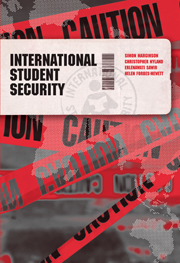Book contents
- Frontmatter
- Contents
- List of figures
- List of tables
- About the authors
- Preface
- PART 1 Students in the global market
- 1 The students
- 2 The setting: Australia
- 3 The global student market
- 4 Student security and regulation
- PART 2 Security in the formal and public domain
- PART 3 Security in the informal and private domain
- PART 4 Protection and empowerment
- References
- Index
2 - The setting: Australia
Published online by Cambridge University Press: 05 August 2012
- Frontmatter
- Contents
- List of figures
- List of tables
- About the authors
- Preface
- PART 1 Students in the global market
- 1 The students
- 2 The setting: Australia
- 3 The global student market
- 4 Student security and regulation
- PART 2 Security in the formal and public domain
- PART 3 Security in the informal and private domain
- PART 4 Protection and empowerment
- References
- Index
Summary
I've heard patients say stuff to me, but nothing in a racist sort of way. More like ‘Don't Asians have blue eyes?’ A woman actually asked me that. Like, what planet are you from? (laughs) Blue eyes! …. So yeah, I do get some remarks that make you stand out. People have preconceptions when they see me. And they immediately stereotype … often white people are surprised when I open my mouth and start speaking English to them. They can't believe I can speak English. And I say to them, do you believe I just got here six months ago (laughs) … I think I'm more Australian than some Australians.
~ female, 26, medicine, MalaysiaINTRODUCTION: THE NATIONAL FACTOR
International students in Australia have similar experiences to their counterparts in other English-speaking countries — the USA, the UK, New Zealand and Canada — especially those who are non-white students from countries where English is a foreign language. This will show in the research literature and the interview findings in parts 2 and 3. All non-citizen students who cross borders for study face common issues and problems, including those who go to China, Japan, Malaysia, Singapore and India. For students crossing borders within the European Higher Education Area the experience is not as foreign as it once was. Nevertheless all students away from home, studying in unfamiliar institutions and daily using a new language, face challenges, the more so if they arrange their own accommodation and must work part time to survive.
- Type
- Chapter
- Information
- International Student Security , pp. 24 - 35Publisher: Cambridge University PressPrint publication year: 2010



